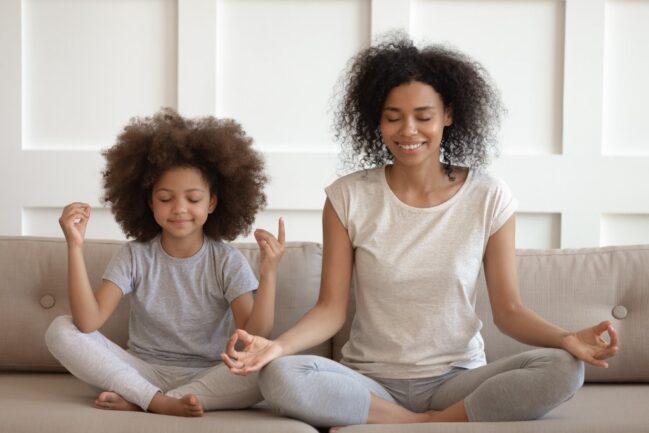Blog
Five Ways to Help Children Relax
August 4, 2021
4 minutes, 27 seconds

Relaxation is essential to help to combat stress and help us to cope with the rigors of everyday life and that applies to everyone – irrespective of age. We don’t always acknowledge it, but life can be stressful for children too and supporting them with effective relaxation techniques can be really helpful – and also set up some great habits for them as they grow into healthy adults. The following are some useful relaxation techniques that work just as well whatever your age!
1. Breathing Exercises
Calm breathing is a technique that helps us to slow down our breathing when we’re feeling stressed or anxious.
When we are anxious, we tend to take short, quick, shallow breaths or even hyperventilate. This type of shallow breathing actually increases other feelings of anxiety (e.g. heart racing, dizziness, or headaches) Calm breathing can help lower anxiety and it really is a ‘portable’ tool that no one knows we are doing.
It’s also very easy for both adults and children:
Encourage your child to take a slow breath in through the nose (for about 4 seconds) and then hold the breath for 1 or 2 seconds. Exhale slowly through the mouth (over about 4 seconds). Wait 2-3 seconds before taking another breath (5-7 seconds for teenagers). Repeat for at least 5 to 10 breaths
‘Bubble blowing’ is a fun way for younger children to practice some of this. Ask them to take a slow, deep breath to make a big bubble, blowing really slowly or it will pop. The challenge is to make the bubbles as big as possible – that will teach children to breath in a controlled way.
2. Progressive Muscle Relaxation
Progressive muscle relaxation offers a wonderful way to relieve stress. This is accomplished by tensing and then relaxing different muscle groups in your body:
- Face - Ask your child to scrunch up her nose and forehead like she smells something horrid, and then have her relax her face. Repeat three times.
- Jaws - Ask your child to clench her jaws together tightly like she's a dog hanging on to a bone, and then have her release that imaginary bone and let her jaw go completely loose. Repeat three times.
- Arms and shoulders - Ask your child to stretch her arms out in front of her, and then raise them above her head and stretch as high as she can. Have her drop her arms and let them hang loose. Repeat three times.
- Hands and arms - Ask your child to imagine squeezing an orange as hard as she can with one hand, and then dropping that orange on the floor and letting her arm and hand go limp. Repeat three times, and then switch to the other arm.
- Stomach - Have your child lie on her back and clench her stomach muscles as hard as she can for just a moment. Have her release them and relax. Repeat three times, and then have her do the same technique while standing up.
- Legs and feet - Have your child stand and press her toes against the floor as though she is digging them into sand at the beach. Have her alternately press them and spread them enough to feel it in her legs, and then have her relax. Repeat three times.
With each of these techniques, encourage your child to notice how comfortable her body feels when she relaxes each portion. The goal is to work through these exercises to achieve full body relaxation. This can be a great way to calm down and relax at the end of a busy day and can aid restful sleep.
3. Exercise
Exercise is a great form of relaxation. Walking, running, swimming and even just active playing all provide the kind of exercise that children love. It can be fun to exercise to music too, which many children really love. Think of exercise in the broadest sense – climbing a tree, for example, exercises lots of muscle groups, as does playing hide and seek in the park or playing on the swings in the playground.
4. Visualization
Visualization is also known as visual guided imagery. This technique uses the imagination to slow down the chatter of the mind and help release negative thoughts and worries and children can be great at this because their imagination is so alive! This technique can be especially useful following progressive muscle relaxation, which first relaxes the muscles and then calms the mind. Imagining a beautiful, peaceful place is one type of visualization that most children can engage with.
- Colour visualization can also be helpful and is a very simple technique to teach a child.
- Ask your child to imagine a favourite colour that makes her feel peaceful and safe.
- Have her imagine taking in that colour with each breath and sending it throughout her entire body as she exhales.
- Have her continue until she visualizes being filled with her special, relaxing colour.
5. Laughter
Laughter is a wonderful stress reliever that soothes tension and helps the body relax.
Ways to encourage your child to laugh include:
- Telling jokes
- Taking turns making silly faces
- Watching a funny cartoon
All of these are simple ideas, most of which can be done anywhere and are completely free! Perhaps you could do them with your child and set up great new relaxation and self-care regimes for both of you.
Good luck 😊